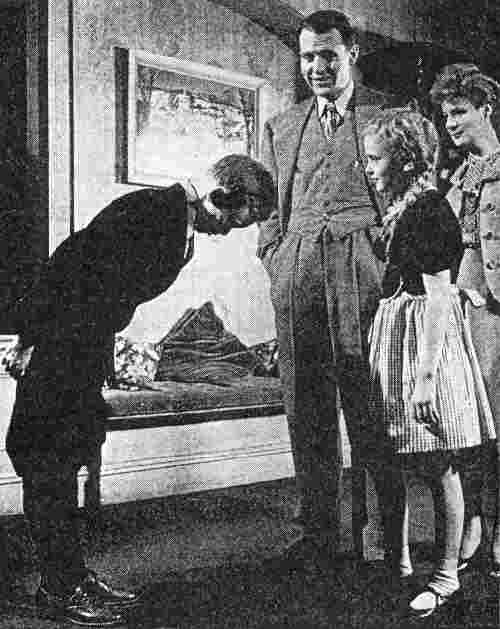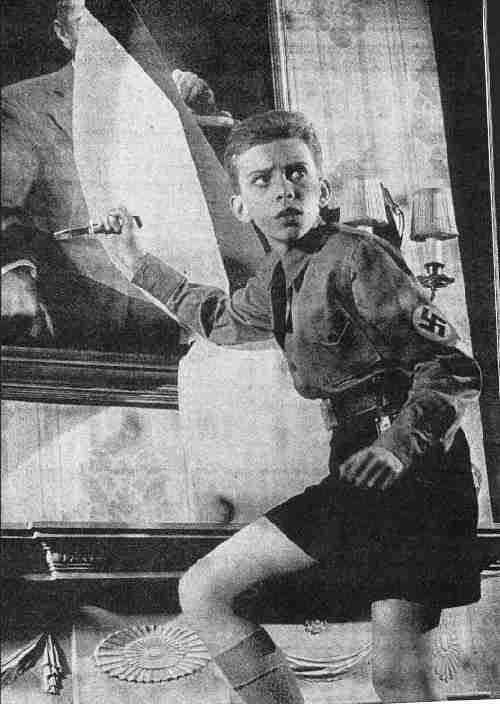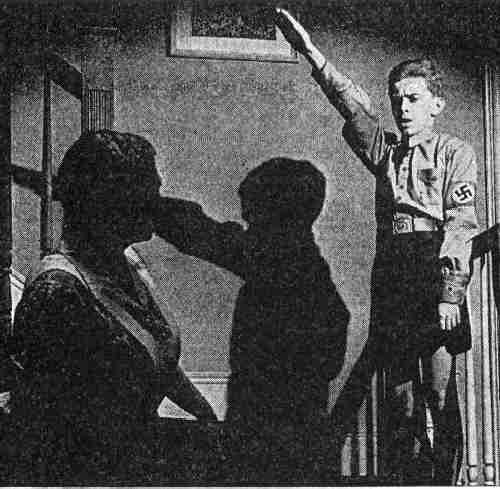
Figure 1.--Emil wears a balck knickers suit when he arrives in America. His new family is charmed with his Old World manners.


Figure 1.--Emil wears a balck knickers suit when he arrives in America. His new family is charmed with his Old World manners. |
An orphaned Hitler Youth comes to America to live with his mother's brother. The arrogance and contempt inculcated in him by the NAZIs strains his relationship with his new family and schoolmates. Their efforts at rehabilitation are futile until an act un vilonce by the boy causes a belated change of heart. This World War II drama dealt with Hitler's seduction of German Youth. Few who saw it realized that it only scratched the suface of the Third Reich and how terribly successful the NAZIs were in deluding an entire generation of young people. It was Skippy Homeier's film debut. He had performed this role in live theater the year before. The film and play deal with a Hitler Youth boy who can not accept his father's oppostion to his beloved FŘhrer and the NAZIs. He has one scene in both play and film in an Hitler Youth uniform.
Tommorrow the World! was a sucessful Broadway play in the Spring of 1943 during the height of World War II. Skippy Homeier was cast as the Hitler Youth boy Emil. Ralph Bellamy played his uncle and Shirley Booth played his uncle's fianceÚ.
The successful Broadway play was made into a film in 1944. Skippy was again past as Emil. Frederic March played the uncle and Betty Field played the fianceÚ.Agnes Morehead had a small part beautifully played. Ring Lardner Jr. co-wrote the script. Hollywood wanted a film that would match the popularity of the Broadway play.
The Hitler Youth boy Emil in both the play and film was Skippy Homeier. Skippy was born on Actober 5, 1930 in Chicago. Tommorrow the World, however, was Skippy's only major role. As an adult he had many bit parts on television.
The plot here is from the filom version. It appears to follow the play, but there could be some differences.
Emil Bruckner, a 13-year old ardent Hitler Youth boy, loses both his parents. They were both political disidents and pacifists and after being arrested by the Gestapo die in concentration camps. Emil is brought to America by his mother's brother.

Figure 2.--Emil is shown here destroying the portrait of his father, an anti-NAZI who died in a concentration camp. |
Emil's American brother is a widower with a dauhter the boy's age. His mother's unmairred sister also lives with her brother. There is also Frieda, a German born housekeeper. The family has eagerly anticipated Emil's arrival. At first his old world manners abd foibles with the English language charm them. Soon this changes. Emil insults his uncle's fianceÚ who is Jewish. The family sences trouble.
Emil goes to his room to change clothes and was up for lunch. He emerges from his room in his treaued Hitler Youth uniform which he had brought to America by wearing it under his black knicker suit that he wore when he arrived. Emil has learned that his uncle is a research professor doing military work. He wants to ferret out any information possible which might prove useful to the Fatherland. As Emil makes his way downstairs from his room, he beckons to Freida the German maid to follow him outside. Freida is shocked to see Emil in a Hitler Youth uniform and tells him that it is a bad joke that he is playing. Emil of course is serious and thinks that since Frida is German that she will help him find valuable information that can be sent back to Germany. Once she realizes that Emil is serious, Freida looks contemsously at his Hitler Youth uniform and tells Emil that she is a loyal American. She walks back inside and tells the family what has just transpired.
The family and especially his uncle's fianceÚ try to be understanding, but firmly insist that he change out of his uniform before joining them for lunch. His uncle's fiancÚ is also his daughter's school teacher. Emil joins her class. He turns out to be a juvenile monster. He will lie, steal, bully, and threaten to get his way. He is sent home one aafternoon after a nasty confrontation with a classmate. Emil writes an obsenity about his teacher on the school sidewalk with a piece of chalk. The teacher goes to Emil's home, confronts him, and slaps his face.
Emil seens his uncle locking up some papers in his desk drawer. While trying to pick the lock, he's surprised by his cousin. Despite all the trouble Emil has caused, she still loves him and is planning to give him a birthday party. She has chosen a wristwatch he coveted as a gift. Emil trys to get his cousin to promise that she will not tell her father that Emil was trying to pick the lock on the desk drawer. She promises not to as she does not think that it is very important.
On the day of Emil's birthday party, his cousin has to coax three classmates, all boys, to come. None of them like Emil. Before the party begins, however, Emil angers his cousin and she hints that she will tell her father what Emil was doing. Emil follows her into the basement and knocks her unconcious with a heavy object. Freida discovers the girl and scrams for help. Emil runs by the boys who are his party guests and out of the house. The boys chase after him and one boy finds him. He thrashes Emil and bring him home.
Now his uncle is understandably past all understanding. The police are called to take Emil away. Before they arrive, however, his uncle loses his temper with Emil and almost chokes him to death. He's stoped by his fianceÚ. Emil shaken and now remorseful seens ready to change his ways.

Figure 3.--Emil here confronts Freida and assumes that, since she is German, that she will help him steal secrets from his uncle's government work. |
Emil wears a variety of clothes. He arrives in America in a black knickers suit, white shirt, and tie with black stockings and rather high buttoning shoes. I have seen German boys wearing knicker suits, but not black knickers suits. This seems more Americam. The most notable outfit is his Hitler Youth uniform. The Hitler Youth uniform in the play seems basically authentic. It includes a brown shirt, black short pants, grey kneesocks, and black shoes with a Hitler Youth belt buckle. The arm band has a swasastika as worn by the SA and SS, but it is not the Hitler Youth arm band with the white stripe. In the play Emil wears a tie with his uniform, but open necks and kerchiefs were more common for the Hitlaer Youth. I'm not sure if the arm band was more authentic. At school, Emil and the other boys where typical 1940s American boys clothes, long sleeved sports shirts, and long trousers. The boys also appear in rather full cut suits or sports with long trousers. None of the boys wear shorts.
Emil's cousin Patricia always wears dresses with white socks and Mary Jane strap shoes, in some scenes with pinafores. This and hder pigtails emphasizes her inosence as she tried to befriend Emil.
Both the play and the film were sucessful. American audiences were hiorrified at the depiction of NAZI indoctrination of the young. Of course we now know that these productions only cratched the surface of the horrors prepetrated by the Third Reich.
HBC thinks that the play and movie did not fully appreciate the evil of NAZI Germany. We are not at all certain that even family members would have been allowed to have taken a boy out of Germany. We are also not certain how the children of discedents were dealt--especially if they had no family in Germany. I have read accounts as to how children were taken away from oarents in some of the Comminist countries after the WAr. I have not read of similar accounts in Germany. Presumably they would have gone to an orphange. The chance of anti-NAZI Americans getting them out of such institutions is questionable. I'm not sure just what year the film was set. Before the war, getting a boy out of German would have been difficult. After the War began it would have been virtually impossible. The ulta pastrotic presumaby would have not like the ideaa of sending a German boy to Anerica.
Another problen with the film is Emil's sudden conversion at the end of the film. Emil's conversion from dedicated Hitler Youth to compliant family member is rather conmtrived and far to sudden. Not very believable.
Still the film is entertaing to watch and generally well acted. Hitler himself had said that he wanted a new generation that was "a hard as Krup steel" with the "preadatoy instincts of the beast". With these children would rule "Germany" today and tomorrow the world. would
Navigate the Boys' Historical Clothing Web Site:
[Return to the Main play list page]
[Return to the Main theatrical page]
[Introduction]
[Activities]
[Biographies]
[Chronology]
[Cloth and textiles]
[Clothing styles]
[Countries]
[Topics]
[Bibliographies]
[Contributions]
[FAQs]
[Glossaries]
[Images]
[Satellite sites]
[Tools]
[Boys' Clothing Home]
